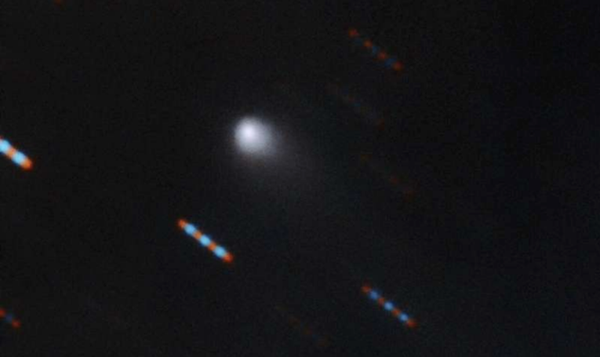Borisov, the interstellar comet, is captured as it approaches the Sun – Astronomy Magazine
The Gemini Observatory in Hawaii caught this first-ever color image of the interstellar comet Borisov and its faint tail in September.
omposite image by Travis Rector. Image Credit: Gemini Observatory/NSF/AURA
In the meantime, astronomers around the world have turned their telescopes to get a good look at this interstellar visitor while it’s here.
Here are some of our favorite shots.
Composite image by Travis Rector/Gemini Observatory/NSF/AURA)
The Gemini Observatory in Hawaii caught this first-ever color image of the interstellar comet Borisov and its faint tail in September.
NASA, ESA, D. Jewitt
In October, the Hubble Space Telescope captured this shot of 2I/Borisov, which distinctly shows the concentration of dust around the comet’s nucleus, separate from the rest of the comet’s fuzzy appearance. The nucleus itself is too small to see with Hubble.
P. van Dokkum, G. Laughlin, C. Hsieh, S. Danieli/Yale University
Astronomers captured this shot of Comet 2I/Borisov, an interstellar space rock passing through our solar system, with the Keck Observatory, Hawaii, in November. According to astronomers who captured this image, the comet’s tail was several times longer at this point than Earth is across.
NSF’s National Optical-Infrared Astronomy Research Laboratory/NSF/AURA/Gemini Observatory
Astronomers used the Gemini Observatory in Hawaii to capture this view of the interstellar comet Borisov along with some background galaxies in November. Because they combined multiple images to create the shot, they needed to average the location of the comet in the photos since it had moved relative to the galaxies.
NASA, ESA, J. Olmsted, F. Summers (STScI)
This illustration shows comet Borisov’s path through our solar system in the panel on the left. The panel on the right shows where Borisov was relative to Earth when the Hubble Space Telescope observed it in October.
ESA/Hubble, NASA, ESO, M. Kornmesser
This artist’s illustration depicts ‘Oumuamua, the first-known interstellar space rock to visit our solar system. While ‘Oumuamua was different from rocky objects in our solar system in many ways, the interstellar comet Borisov seems similar to solar system comets, astronomers have found.


 FULL SCREEN
FULL SCREEN






